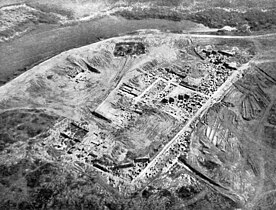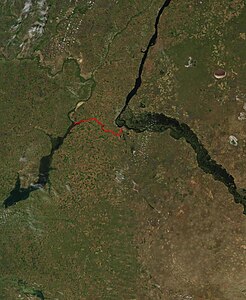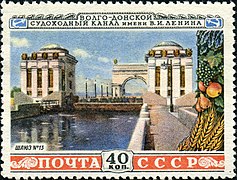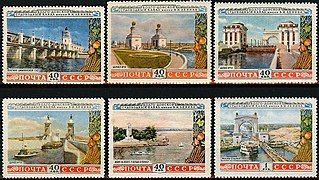Volga–Don Canal
| Volga–Don Canal | |
|---|---|
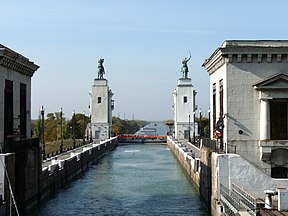 Volga–Don Canal in October 2009 | |
 | |
| Specifications | |
| Length | 63[1]miles (101 km) |
| Maximumboat length | 141 m (463 ft)[2] |
| Maximumboat beam | 16.8 m (55 ft)[2] |
| Maximumboat draft | 3.6 m (12 ft)[2] |
| Locks | 13[3] |
| Maximum height above sea level | 144 ft (44 m) |
| Status | Open |
| History | |
| Construction began | 1948 |
| Date of first use | 1 June 1952 |
| Date completed | 1952 |
| Geography | |
| Start point | Volgograd,Russia |
| End point | Tsimlyansk Reservoir,nearVolgodonsk,Russia |
| Beginningcoordinates | 48°37′21″N43°32′06″E/ 48.62250°N 43.53500°E |
| Endingcoordinates | 48°31′21″N44°33′09″E/ 48.52250°N 44.55250°E |
Lenin Volga–Don Shipping Canal(Russian:Волго-Донской судоходный канал имени,В. И. Ленина, Volga-Donskoy soudokhodniy kanal imeni V. I. Lenina,abbreviated ВДСК,VDSK) is a shipcanalinRussia.It connects theVolgaand theDonat their closest points. Opened in 1952, its length is 101 km (63 mi), 45 km (28 mi) of which is throughriversandreservoirs.
The canal forms a part of theUnified Deep Water System of European Russia.Together with the lower Volga and the lower Don, the canal provides the shortest navigable connection between theCaspian Seaand the world's oceans via theSea of Azov,theBlack Sea,and theMediterranean Sea.
History[edit]
There has been a trade and military route between theVolgaandDonrivers since early human history.
The presence of the fortified settlementTanaisin the Don River delta since the time of theBosporan Kingdom,c.438 BC– 370 AD, strongly suggests the route was sufficiently notable to be fortified for over two thousand years. TheSarkelfortress on theleft bankof the lower Don was the main control of thisVolga trade route.[4]
TheDon–Volga portagegot its name from its trade importance 1000 years ago.[5]
In 1569, theOttoman Empireattempted to connect the Volga and Don rivers via a canal. The Ottomans wanted to create a maritime link toCentral Asia(especially the cities ofBukhara,KhwarazmandSamarkand) to facilitate trade.[6]Together with a proposedSuez Canal,the Volga–Don canal would also allowCentral Asian Muslimsto performpilgrimage to Mecca.[6]According to most historians, the Ottomans managed to dig one-third of the canal[7][8]before work was abandoned because of adverse weather.[9]Other historians argue that the Ottomans merely leveled the ground so they could haul ships between the two rivers.[10]In the end, the Ottomans retreated from the area and Russia promised to respect trade and pilgrimage routes to Central Asia.[6]
Peter the Greatordered the earliest Russian attempts to connect the Volga and Don rivers.[11]After capturingAzovin 1696, he decided to build a canal — later namedPetrov Val— on theIlovlya River(a left tributary of the Don) and theKamyshinka river(right tributary of the Volga).[12][13]It was much shorter than the modern canal, connecting a gap of just 4 kilometers (2.5 mi), but was abandoned in 1701 because of a lack of resources and other problems.[14]He initiated a second attempt, the so-calledIvanovsky CanalbetweenYepifanandIvan-Ozero,under the administration ofKnyazMatvey Gagarin.However it was too shallow, as it linked the upper Don and the upper Volga via the tributariesOka River,Upa River,andShat Riverin present-dayTula Oblast.Between 1702 and 1707, twenty-fourlockswere constructed, and in 1707, about 300 ships passed through with difficulty. In 1709 owing to financial difficulties from theGreat Northern War,the project was halted.[15]
In 1711 Russia left Azov under the terms of theTreaty of the Pruth,and Peter the Great lost all interest in the canal, which was abandoned and fell into ruin.[16][17]Over time, other projects for connecting the two rivers were proposed, but none were attempted. However, the horse-drawnDubovsko-Kachalinsky railwayand theVolga–Don railway— now part of theSouth Eastern Railway— were built in 1846 and 1852, respectively, to link the Volga and the Don at the shortest distance.[18]They were 68km and 73km long respectively.[19][20]
The construction of today's Volga–Don Canal, designed bySergey Zhuk'sHydroprojectInstitute, began prior to theSecond World War,which interrupted the process. Construction works continued from 1948 to 1952 and the canal was opened on 1 June 1952. The canal and its facilities were built by about 900,000 workers including some 100,000 German POWs and 100,000gulagprisoners. A day spent at the construction yard was counted as three days in prison, which spurred the prisoners to work. Several convicts were even awarded theOrder of the Red Banner of Labourupon their release.
Upon completion, the Volga–Don Canal became an important link in theUnified Deep Water Transportation Systemof theEuropeanpart of theUSSR.
Operation[edit]
The canal begins at the Volga's Sarepta backwater (48°31′10″N44°33′10″E/ 48.51944°N 44.55278°E,the location of Lock No. 1 and the gateway arch), south ofVolgograd.It ends in theTsimlyansk Reservoirof the Don at the town ofKalach-na-Donu.The canal's highest elevation is the Varverovskoye (Barbarian) Reservoir between locks 9 and 10, 88 m (289 ft) above the Volga and 44 m (144 ft) above the Don river. It uses nine single-chambercanal lockson the Volga slope to raise and lower ships 88 m (289 ft), and four canal locks of the same kind on the Don slope that raise/lower ships 44 m (144 ft) from river height. The locks are smaller overall than those on the Volga River, but can handle ships of up to 5,000tonnescargo capacity.
The smallest locks are 145 m (476 ft) long, 17 m (56 ft) wide, and 3.6 m (12 ft) deep. The maximum allowed vessel is 141 m (463 ft) length, 16.8 m (55 ft) beam, and 3.6 m (12 ft) draught (theVolgo–Don Max Class).[2]
The canal is filled from the Don, with three powerfulpumping stationsto maintain water levels. Water is also taken from the canal for irrigation.
Cargo transported from the Don region to the Volga includes coal fromDonetsk in Ukraine,minerals, building materials, and grain. From the Volga to the Don, cargo includeslumber,pyrites,andpetroleum products(carried mostly byVolgotankerboats).
Tourist cruisers travel in both directions.

The canal and theTsimlyanskywater-engineering system (whose chief architect was Leonid Polyakov), form part of anarchitectural ensemblededicated to the battles forTsaritsynduring theRussian Civil Warand forStalingradduring theGerman-Soviet War.
The RussianclassicalcomposerSergei Prokofievwrote thetone poemThe Meeting of the Volga and the Donto celebrate its completion.
According to the Maritime Board (Morskaya Kollegiya) of the Russian government, 10.9 million tonnes of cargo were carried over the Volga–Don Canal in 2004.[21]An alternative source claims 8.05 million tonnes of cargo was transported through the canal in 2006. Most of the cargo was moved from the east to the west: 7.20 million tonnes, and only 0.85 million tonnes the other way. Just over half of all cargo was oil or oil products (4.14 million tonnes), predominantly shipped from the Caspian region.[22]
It was reported in 2007 that in the first 55 years of the canal's operations 450,000 vessels had passed through carrying 336 million tonnes of cargo. Recent cargo volume stood at 12 million tonnes per year.[23]
In 2016, the core ofBelarusian nuclear power plantVVER-1200,which weighed 330 tonnes, was 13 meters high, and 4.5 meters in diameter, was transferred to its destination by exploitingTsimlyansk Reservoir,the Volga–Don Canal, theVolga–Baltic Waterway,and two other connections.[24]
Stamp gallery[edit]
-
USSR stamp, 1953: Lock No. 13
-
USSR stamp, 1951
-
USSR stamp, 1952
-
Russia Stamp 2008
-
USSR collection
-
Illustration of alockon the Volga–Don Canal (1953) (47°33′5.84″N42°08′10.26″E/ 47.5516222°N 42.1361833°E)
-
Tsimlyansk hydroelectric power plant (1953)
Future options[edit]
In the 1980s, construction started on a second canal between the rivers. The new canal, dubbed Volga–Don 2 (Russian:Волго-Дон 2;48°56′37″N44°30′25″E/ 48.94361°N 44.50694°E) would start from the township ofYerzovkaon theVolgograd Reservoir,north (upstream) of theVolga Dam,as opposed to the existing Volga–Don Canal that starts south (downstream) of the dam.[25]This would reduce the number of locks traversed by ships coming from the Volgograd Reservoir, or from other Volga orKamaports farther north, on their way to the Don. The project was abruptly cancelled to cut expenditure on 1 August 1990, by which time more than 40 percent of its funds had already been spent.[25][26][27]Since then most of the stone and metal in the abandoned canal and locks has been looted.[28]
As of 2007–2008, Russian authorities are considering two options for increasing thethroughputof navigable waterways between the Caspian basin and the Black Sea. One option, which reuses the name "Volga–Don 2", is to build a second parallel channel ( "second thread" ) of the Volga–Don Canal, equipped with larger locks 300 metres (980 ft) long. This plan would allow for an increase in the canal's annual cargo throughput from 16.5 million tonnes to 30 million tonnes. The other option, which seems to have more support fromKazakhstan,[29]which would be either canal's major customer, is to build the so-calledEurasia Canalalong a more southerly route in theKuma–Manych Depression,some of which is the much shallowerManych Ship Canal.Requiring less digging than the first option and of little use to traffic to and from the Volga, it would provide a speedier connection between the Caspian and the Sea of Azov. It would also require fewer locks than the Volga–Don, as elevations in the Kuma–Manych Depression are lower.[30]
See also[edit]
References[edit]
- ^Сроки работы шлюзов (Lock operation periods), from the site of the Russian Shipping Companies' Association(in Russian)
- ^abcdEgorov, E. V.; I. A. Ilnytskyi; V. I. Tonyuk (2015)."Dimensional Line-up of River-sea Navigational Tankers".In Guedes Soares, Carlos; Roko Dejhalla, Dusko Pavletic (eds.).Towards Green Marine Technology and Transport.Boca Raton, Fla., US: CRC Press. p. 518.ISBN9781315643496.Retrieved19 May2020.
- ^"Volga-Don Canal - canal, Russia".Encyclopedia Britannica.Retrieved20 April2018.
- ^Elhaik E(2020)Diverse genetic origins of medieval steppe nomad conquerors – a response to Mikheyev et al(2019).
- ^"CA&CC; Press AB".Archived fromthe originalon 20 July 2009.
- ^abcGiancarlo Casale.The Ottoman Age of Exploration.pp. 135–7.
- ^Halil İnalcık.The Origin of the Ottoman-Russian Rivalry.pp. 79–80.
- ^Elvin, Mark; Liu, Cuirong; Liu, Ts'ui-Jung (13 January 1998).Sediments of Time: Environment and Society in Chinese History.Cambridge University Press. p. 33.ISBN9780521563819.
The project was abandoned when one-third complete
- ^Colin Imber.The Ottoman Empire, 1300-1650: The Structure of Power.p. 44.
- ^A. N. Kurat. "The Turkish Expedition to Astrakhan' in 1569 and the Problem of the Don-Volga Canal".
{{cite journal}}:Cite journal requires|journal=(help) - ^"Where is the Volga-Don Canal?".25 April 2017.
- ^"Город Петров Вал (Волгоградская область)".
- ^Ilovlya (river in the RSFSR) // Great Soviet Encyclopedia: [in 30 vol.] / Ch. ed. A.M. Prokhorov. - 3rd ed. - M.: Soviet Encyclopedia, 1969-1978.
- ^Minh A. N. Historical and Geographical Dictionary of the Saratov Province / Comp. A.N. Minh. - Saratov, 1898-1902. - 5 t. - App. To the Works of the Saratov Scientific Archival Commission. - S. 383
- ^Milena Zolotareva (January 2019)."Environmental planning and management of waterway construction (historical experience of Russia in the 18th century and the beginning of the 19th century)"(PDF).
- ^Плечко Л.А.: Старинные водные пути.Сервер для туристов и путешественников Скиталец. Информационный сервер обо всех видах туризма(in Russian). Archived fromthe originalon 17 March 2019.Retrieved20 April2018.
- ^это... Что такое Ивановский канал?.Словари и энциклопедии на Академике(in Russian).Retrieved20 April2018.
- ^Skolkov G.S. Tsaritsyn-Stalingrad in the past. - Stalingrad: Edition of the Stalingrad island of local history, 1928. - T. The first essay, 1589-1862.
- ^Collection of freight surface distances of Russian railways / Comp. I.F.Sauer. - St. Petersburg: Br. Panteleev, 1893. - S. 10. - 114 p.
- ^Minh A.N. Dubovsko-Kachalinskaya railway // Historical and geographical dictionary of the Saratov province. - Saratov: Printing house of the provincial zemstvo, 1898. - T. 1, issue 2. - S. 276-277.
- ^Морская коллегия: Речной транспортArchived7 March 2008 at theWayback Machine(Maritime Board: River Transport)(in Russian)
- ^"Взвесить все"(Supplement to theKommersantnewspaper, No. 195/P(4012), 27.10.2008(in Russian)
- ^«Водный мир» для Евразии( "Eurasia's 'Water World'";Archived4 March 2008 at theWayback Machine),Transport Rossii,No. 28 (472) 12 July 2007(in Russian).
- ^"В Белоруссию привезли первый реактор для строящейся АЭС".
- ^abПетр ГОДЛЕВСКИЙ,«ВОЛГО-ДОН 2» — ШАГ В БУДУЩЕЕArchived22 July 2011 at theWayback Machine.«Торговая газета», номер 4-5(434—435) от 23.01.2008
- ^D. J. Peterson, «Troubled Lands: The Legacy of Soviet Environmental Destruction»Chapter 3
- ^"ВОЛГО-ДОН-II: МЫ СТРОИЛИ, СТРОИЛИ И ЧТО?"(We have been building... So what? ") Журнал «Власть» (Kommersant-VlastMagazine), No. 30, 30.07.1990(in Russian)
- ^"Строительство второго Волго-Донского канала, на нужды которого в свое время было затрачено 750 миллионов рублей, было заморожено 10 лет назад. А приехавшие по призыву комсомола люди так и остались там жить."(14.11.2000)
- ^Nazarbayev insists on Eurasian canal constructionArchived5 May 2005 at theWayback MachineKazinform, 22 May 2008
- ^"Analysis: Russia, Kazakhs eye rival canal".United Press International.Archived fromthe originalon 9 February 2008.


